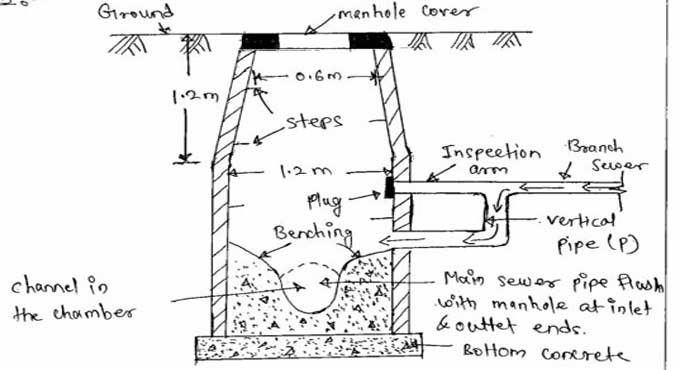
Unveiling the Depths: Understanding Drop Manholes, Construction, and Their Vital Components

Manholes, those unassuming covers on our streets and sidewalks, are much more than meet the eye. Beneath their unpretentious exteriors lies a complex network of structures designed to manage and maintain our underground utilities.
What Is a Drop Manhole?
Let's start by demystifying the term "drop manhole." A drop manhole, also known as a drop structure or drop shaft, is a vertical structure that facilitates the transition of flow levels within a sewer or stormwater system. These structures are strategically placed in a pipeline to manage changes in elevation, ensuring the smooth flow of water or wastewater.
The term "drop" refers to the vertical distance between the incoming and outgoing flow levels. Drop manholes play a crucial role in preventing excessive turbulence, erosion, and potential damage to pipelines caused by abrupt changes in water flow.
Manhole Construction: A Closer Look
1. Excavation
The process begins with excavation at the designated location. The size and depth of the manhole depend on the specific requirements of the sewer or stormwater system.
2. Base Construction
The base, or the floor, of the manhole is constructed using concrete. This provides a stable foundation for the entire structure.
3. Installation of Components
Key components, such as inflow and outflow pipes, benching, and drop structures, are carefully installed. These components are crucial for regulating the flow within the manhole.
4. Walls and Cover
The walls are constructed using precast concrete rings or poured-in-place concrete. The manhole is then topped with a cover, usually made of cast iron, to allow easy access for inspection and maintenance.
5. Backfilling
The excavated area around the manhole is backfilled to secure the structure in place and restore the surface.
Types of Manholes
1. Drop Manholes
Drop manholes, as discussed earlier, are designed to manage changes in elevation within a sewer or stormwater system.
2. Sanitary Sewer Manholes
These manholes are integral components of sanitary sewer systems, collecting and transporting wastewater from residential, commercial, and industrial areas.
3. Stormwater Manholes
Stormwater manholes are designed to manage rainwater runoff, preventing flooding and erosion by redirecting excess water to appropriate drainage systems.
4. Combination Manholes
Combination manholes serve dual purposes, accommodating both sanitary sewer and stormwater flows. They are versatile solutions for areas with complex drainage needs.
Purpose of Manholes
1. Access for Inspection and Maintenance
Manholes provide entry points for inspection and maintenance activities. This accessibility is crucial for identifying and addressing issues within the sewer or stormwater system.
2. Flow Control
By incorporating drop structures, manholes help regulate the flow of water, preventing turbulence and erosion that can occur when there are abrupt changes in elevation.
3. Interconnection
Manholes enable the interconnection of pipelines, facilitating the smooth transfer of wastewater or stormwater between different segments of the system.
4. Preventing Overflows
In stormwater systems, manholes play a pivotal role in preventing overflows during heavy rainfall by redirecting excess water to appropriate outlets.
Manhole Components
1. Inflow and Outflow Pipes
These pipes are the conduits for wastewater or stormwater entering and leaving the manhole. Proper alignment and sizing are crucial to maintain the flow capacity of the system.
2. Benching
Benching refers to the construction of steps or platforms within the manhole. It provides a stable surface for maintenance workers and helps control the flow of water within the structure.
3. Drop Structures
Drop structures, including drop manholes, manage changes in elevation by providing a gradual transition for water flow, reducing the risk of turbulence and erosion.
4. Manhole Covers
Made of durable materials like cast iron, manhole covers ensure the safety of pedestrians and vehicles while providing easy access for inspection and maintenance.
5. Ladder or Steps
For safe entry and exit, manholes are equipped with ladders or steps, allowing workers to descend into the structure securely.
Define Appurtenances
In the context of manholes and utility structures, the term "appurtenances" refers to additional features or attachments that enhance their functionality. Appurtenances are designed to improve the performance, safety, and accessibility of these structures.
Appurtenances Examples
1. Manhole Riser Rings
Riser rings are added to manholes to adjust the height of the structure, accommodating changes in ground elevation or addressing specific design requirements.
2. Manhole Steps
Steps or rungs are often attached to the interior walls of manholes to provide easy access for workers descending into the structure for inspection or maintenance.
3. Manhole Seals
Seals are installed to prevent infiltration of groundwater into the manhole, maintaining the integrity of the sewer system.
4. Manhole Grates
Grates may be added to manholes to prevent debris or unauthorized access while allowing for proper ventilation.
To learn more, watch the following video tutorial.
Video Source: Civil Engineering Fanatics
5. Manhole Safety Net
A safety net can be installed within a manhole to enhance worker safety by providing a barrier against accidental falls.
Conclusion
Manholes, with their intricate construction and array of components, are unsung heroes of urban infrastructure. Drop manholes, in particular, play a vital role in managing the complexities of sewer and stormwater systems. Understanding their construction, types, purposes, and the significance of appurtenances allows us to appreciate the engineering prowess that goes into creating these unassuming structures.
As our cities continue to evolve, the importance of well-designed and well-maintained manholes becomes increasingly apparent, ensuring the efficient flow and management of our vital underground utilities.


